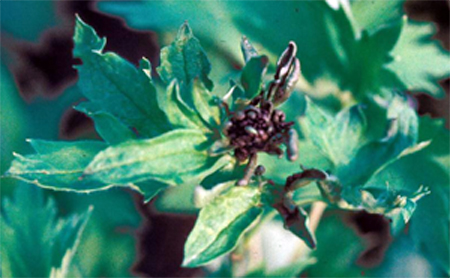Cyclamen mite injury found on Delphinium (Larkspur)
Know how to recognize the symptoms of this microscopic mite.
Tom Dudek reported in our May 4 conference call that some perennial growers have seen cyclamen mite damage to one of our most popular perennial flowers: delphinium. Damage from cyclamen can be difficult to diagnose because the mites themselves are less than 0.3 mm long (Photos 1 and 2). Since they are smaller than a grain of sand, a microscope is needed to confirm their presence. For this reason, diagnosis in the field relies on recognizing the symptoms.

Photo 1. Injury to delphinium caused by cyclamen mite. Photo credit: Leanne Pundt, UConn.

Photo 2. Cyclamen mite (less than 0.3 mm long) and injury to delphinium. Photo credit: N.C. State Univ.
Examine buds and young leaves for darkened tissues, leaves that curl inward and puckering. Pit-like depressions can also form. Infested leaves may become brittle or appear streaked. Flowers can become shriveled and discolored. Sometimes, flower buds may not open at all. In addition to delphinium, cyclamen mite can also be found on outdoor plantings of chrysanthemum, verbena, strawberry, ivy, snapdragon, geranium, fuschia, begonia, petunia, daisy, azalea and viola. Damage to delphinium is particularly severe, as flower stalks become twisted and buds turn black and do not open.
Growers may want to remove infested plants to avoid spread of the mite to surrounding plants. Not all miticides are effective against cyclamen mite and broad mites. Miticides that have cyclamen listed on the label include: Avid, Akari, Judo, Pylon, SanMite and Sirocco. In order to judge how well a miticide works for cyclamen mite, leave some plants unsprayed, and compared symptoms on treated and untreated plants for two weeks after spraying.
For more information on managing cyclamen mites, visit the University of Connecticut’s Managing Cyclamen Mites and Broad Mites in the Greenhouse web site.



 Print
Print Email
Email

